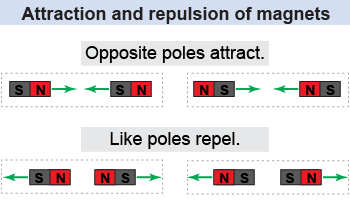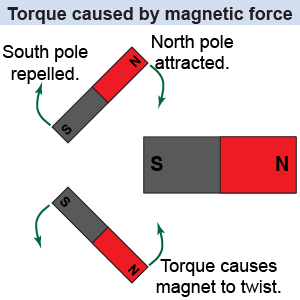|
 A basic property of magnets is that they contain two magnetic poles of opposite polarity, referred to as the magnetic north pole and magnetic south pole. All magnets must have both a north and a south pole. If you cut a permanent magnet in half, each of the halves will have a north and a south pole! This is a fundamental difference between magnetism and electrostatics: You can separate positive charges from negative charges, but you cannot separate a magnetic north pole from its magnetic south pole. You will learn more about electric charges in section 2 of this chapter.
A basic property of magnets is that they contain two magnetic poles of opposite polarity, referred to as the magnetic north pole and magnetic south pole. All magnets must have both a north and a south pole. If you cut a permanent magnet in half, each of the halves will have a north and a south pole! This is a fundamental difference between magnetism and electrostatics: You can separate positive charges from negative charges, but you cannot separate a magnetic north pole from its magnetic south pole. You will learn more about electric charges in section 2 of this chapter. 
|
 When two magnets are close to each other they exert attractive or repulsive magnetic force on each other depending on how their poles are aligned. When opposite magnetic poles—north and south—face each other, the magnetic force is attractive. When similar magnetic poles face each other, north–north or south–south, the magnetic force is repulsive.
When two magnets are close to each other they exert attractive or repulsive magnetic force on each other depending on how their poles are aligned. When opposite magnetic poles—north and south—face each other, the magnetic force is attractive. When similar magnetic poles face each other, north–north or south–south, the magnetic force is repulsive. 
|
Have you ever handled two very strong magnets that, when you joined them together, were stuck so strongly that you could barely separate them? Why do magnets that are so close together stick together so strongly? The answer is that the force between two magnets falls off more rapidly than an inverse-square-law relationship. This also means that the force at shorter distances increases more rapidly than an inverse-square-law relationship. So the forces become extremely strong at short distances, resulting in magnets that are stuck together and very hard to separate from each other! 
 |
The force of gravity between two masses, such as the Sun and the Earth, decreases with distance as the inverse square of their separation, i.e., Fg ∝ 1 / r2. As we will see soon, the electrostatic force between two charges also falls off in the same way, Fg ∝ 1 / r2. But the magnetic field between two bar magnets, which are called magnetic dipoles, falls off more quickly as B ∝ 1 / r3, and the magnetic force itself between two bar magnets falls off even faster—as FB ∝ 1 / r4!
When you double the separation between two masses, their mutual gravitational force decreases by a factor of 22 = 4. But when you double the separation between two bar magnets, their mutual magnetic force decreases by a factor of 24 = 16. Likewise, when you halve the distance between two magnets, their magnetic force increases by a factor of 16, which explains why two strong magnets can get stuck together so strongly! 
|
 Because magnets are dipoles the strength of the magnetic force decreases very quickly as they are separated. Think about the attraction between the north pole of one magnet and the south pole of a second magnet. The south pole of the first magnet is repelled by the south pole of the second magnet. The force between two magnets is an example of a dipole–dipole interaction because it includes four poles: two north and two south. Opposite magnetic forces on the two ends of a bar magnet can create a torque that causes the magnet to twist or rotate. Later in the chapter, we will see how magnetic torque can be used in a simple electric motor.
Because magnets are dipoles the strength of the magnetic force decreases very quickly as they are separated. Think about the attraction between the north pole of one magnet and the south pole of a second magnet. The south pole of the first magnet is repelled by the south pole of the second magnet. The force between two magnets is an example of a dipole–dipole interaction because it includes four poles: two north and two south. Opposite magnetic forces on the two ends of a bar magnet can create a torque that causes the magnet to twist or rotate. Later in the chapter, we will see how magnetic torque can be used in a simple electric motor. 
|
How small do you have to cut a magnet before you can find a single north pole or a single south pole?
 |
You can’t find a single north or south pole of a magnet no matter how small you cut it. Magnets always exist as a north and a south pole together. Magnetic monopoles are not believed to exist. 
|
| |
|

